Strategies to Support Struggling Adolescent Readers, Grades 612
Strategies to Support Struggling Adolescent Readers, Grades 612
Lisa Hollihan Allen and Katherine S. McKnight
ROWMAN & LITTLEFIELD
Lanham Boulder New York London
Published by Rowman & Littlefield
A wholly owned subsidiary of The Rowman & Littlefield Publishing Group, Inc.
4501 Forbes Boulevard, Suite 200, Lanham, Maryland 20706
www.rowman.com
Unit A, Whitacre Mews, 26-34 Stannary Street, London SE11 4AB
Copyright 2018 by Katherine S. McKnight and Lisa Hollihan Allen
All rights reserved . No part of this book may be reproduced in any form or by any electronic or mechanical means, including information storage and retrieval systems, without written permission from the publisher, except by a reviewer who may quote passages in a review.
British Library Cataloguing in Publication Information Available
Library of Congress Cataloging-in-Publication Data
Names: McKnight, Katherine S. (Katherine Siewert), author. | Allen, Lisa Hollihan, author.
Title: Strategies to support struggling adolescent readers, grades 612 / Katherine S. McKnight and Lisa Hollihan Allen.
Description: Lanham : Rowman & Littlefield, [2018] | Includes bibliographical references and index.
Identifiers: LCCN 2018004270 (print) | LCCN 2018006427 (ebook) | ISBN 9781475822076 (Electronic) | ISBN 9781475822052 (cloth : alk. paper) | ISBN 9781475822069 (pbk. : alk. paper)
Subjects: LCSH: ReadingRemedial teaching. | Reading (Secondary)
Classification: LCC LB1050.5 (ebook) | LCC LB1050.5 .M2155 2018 (print) | DDC 372.43dc23
LC record available at https://lccn.loc.gov/2018004270
 The paper used in this publication meets the minimum requirements of American National Standard for Information SciencesPermanence of Paper for Printed Library Materials, ANSI/NISO Z39.48-1992.
The paper used in this publication meets the minimum requirements of American National Standard for Information SciencesPermanence of Paper for Printed Library Materials, ANSI/NISO Z39.48-1992.
Printed in the United States of America
Lisa Hollihan Allen:
This book is dedicated to my parents, Tim and Linda Hollihanboth incredible teachers, in the classroom and at home.
Katherine McKnight:
For David, my soulmate and cheerleader, and my children, Colin and Ellie.
Acknowledgments
First, a colossal thank you to Katie McKnight, who so generously agreed to coauthor this book with me. I am grateful we metand hit it offwhile working together on the Cooperative Educational Service Agency (CESA) 7 ELA Curriculum Companion. Our love for our students and for secondary literacy fueled us to write this book for teachers everywhere.
Thank you to the West De Pere School District, De Pere, Wisconsin, the Board of Education, and Superintendent John Zegers for recognizing and addressing the need for secondary literacy intervention in our district. Thank you to our amazing curriculum director, Amy LaPierre, for being so forward thinking and supportive as she expertly guides all of the literacy people in West De Pere.
Thank you to Missy Hagel, my next door teacher and fellow 612 literacy interventionist, for helping every time I burst into her classroom with statements like, The Google bullets wont listen to me! Thank you to Nicci Verbeten for all of her patient tech assistance.
Thank you to my first English teacher mentor and eventually my teachers principal, Irene Hucek, for listening, teaching, and encouraging. I have worked with some outstanding teachers of literacy. Our conversations, questions, and collaborations make us all better teachers. Thank you Carrie Burch, Laurie Przybylski-LaMere, Ann Barsczc, Jill Miller, Jenny Pierre, Vicki Marotz, Tara VonThoma, and Chris Seroogy.
Thank you to my students. I am so lucky I get to teach. The culture we create in our classroom as were learning makes me love coming to school every day.
And finally, thank you to my family. My husband Scotts belief and support (and pizza from Hot Stone when I was working at our cottage) is appreciated. Thanks also to our kidsPaul and Emilyfor their excitement and interest in my adventures.
Katie would like to thank her coauthor as well. Lisas incredible classroom knowledge is a gift to all teachers. She has a keen ability to translate theory and research into practical strategies to develop the skills that teenagers need to become independent readers.
When Lisa and I first took on this project our focus was always on middle and secondary school colleagues who were frustrated that they didnt have the skills and knowledge they needed to help their students who were struggling with reading in the different disciplines. The National Assessment for Educational Progress consistently documents that the majority of our adolescent readers struggle with proficiency. Consequently, we want to thank our colleagues who gave us feedback, ideas, and encouragement along the way.
Lisa and I would also like to thank Susan Canavan, who offered us suggestions and a tremendous amount of patience. We would also like to thank Elaine Carlson and Kris Lantzy who provided support as we wordsmithed and crafted the manuscript. We are also very grateful to Richard Cash, EdD, whose expertise on self-regulation provided a much needed and appreciated addition to this book.
Introduction
People have been trying to teach me to read since I was in kindergarten. What makes you think you can do it? Bryce, the sullen eighth grader, said.
Bryce sat in Lisas classroom, arms crossed defiantly , with a look of How dare you try to teach me how to read on his face. Bryce was in eighth grade and he had some discipline issuesissues that were directly related to his inability to read. He was frustrated and so far his experience in school had been filled with academic disappointment. Unflappable, Lisa took on the challenge. Drawing on her expertise as a reading specialist, she turned to the Wilson Reading System which systematically teaches students how to decode and encode (spell) through the structure of language, breaking it down into the most basic phonemes.
In a short period of time, Lisa and Bryce found some synergy and trust through their early success. In the subsequent weeks and months, Bryce went from mouthing and using gibberish in choir class to actually reading the lyrics. True, he probably wasnt reading all of the lyrics, but he now had the confidence to try. He was developing the skills he needed to decode textual language.
Lisa also noticed in using the approach that her high school students had similar successes. For example, Quentin, an athletic, personable sophomore, finally learned to read the text and logos on track meet signagelogos that he had previously viewed only as pictures or symbols with no textual meaning. Taylor, a student who had never felt confident in her reading ability, became an eager reader through the read aloud strategy that was a common practice in Lisas class. Taylor transformed from a reluctant reader to one who requested books as gifts and developed greater confidence as an independent reader.
Bryce and his classmates Quentin and Taylor are students who demand our best, and as a result, make us better teachers. They are struggling and discouraged and sometimes demonstrate behavioral issues because they cant read. This book is about themkids like Bryce, Quentin, and Taylor. They can learn to read . We need to provide all of the tools they need to break the code of textual language, even if it happens as late as middle school or high school.
When students are in elementary school, a teacher who has expertise in teaching the fundamentals of reading instructs them. At the middle and high school level that stopsand the timing could not be worse. The common belief is that as soon as students have learned to read , we can expect them to read to learn . The literacy demands increase exponentially, yet typically schools do not teach adolescents how to successfully read the increasingly difficult materials they encounter throughout their day. Literacy instruction needs to continue into middle school and high school, most especially for the students reading below grade level. For whatever reason, these students didnt develop strong literacy skills in elementary school, so now it is our responsibility to continue direct literacy (with a special focus on reading) instruction in middle and high school.
Next page
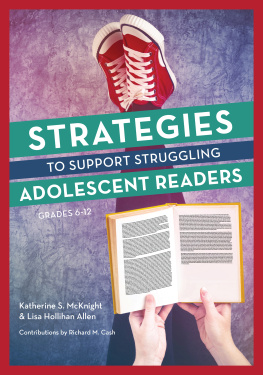

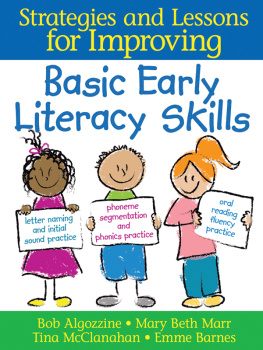

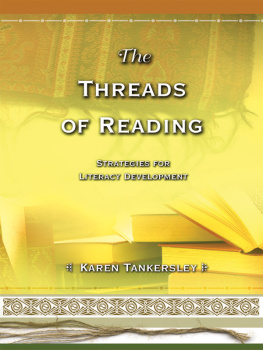
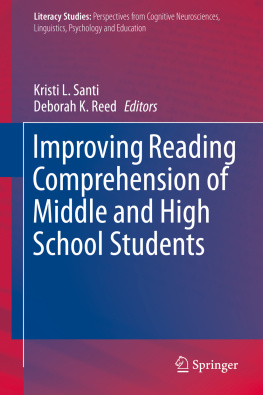

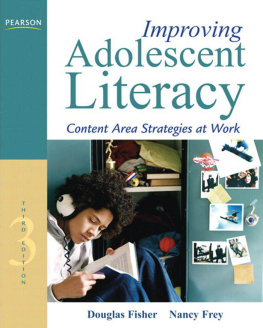
 The paper used in this publication meets the minimum requirements of American National Standard for Information SciencesPermanence of Paper for Printed Library Materials, ANSI/NISO Z39.48-1992.
The paper used in this publication meets the minimum requirements of American National Standard for Information SciencesPermanence of Paper for Printed Library Materials, ANSI/NISO Z39.48-1992.